INTRODUCTION
During product development, quality assurance of pharmaceutical molecules is a matter of great concern in the pharmaceutical industry. Analytical methods are critical elements in product development due to their roles in assisting with process development and product quality control. Poor analytical methods can lead to inaccurate results, resulting in misleading information that may be detrimental to the drug development program. In an endeavor to address such plausible crucial issues, different Pharma regulatory agencies, such as International Council for Harmonisation (ICH) and U.S. Food and Drug Administration, have been transforming by adopting quality by design (QbD) principles to circumvent these quality crises. Recently, ICH has announced new guideline ICH Q14 on analytical procedure development and revision of Q2 (R1) analytical Validation Q2 (R2)/Q14 (ICH Assembly, Kobe, Japan, June 2018).
The traditional liquid chromatographic method development for any drug molecule was performed by a trial and error approach, for example, by varying one-factor-at-a-time and examines the resolution of the result until the best method was found. It is a time-consuming process and required a large amount of manual data interpretation. This approach requires typically some experimental trials, and in some circumstances, the established method requires further modification in method or a supplementary purification stage when scaled up, consequently slackening the drug development process (Monks et al., 2011; Peraman et al., 2015). Moreover, this type of method development provides a limited understanding of a method’s capabilities and robustness. This can be overcome by applying QbD principles to the analytical method development as it uses a statistical experimental design to generate a “method operable design space” of a robust analytical method (Peraman et al., 2015). The method operable design space outlines the experimental operable region in which variations to method parameters will not considerably influence the quality and results of the method. Therefore, it will be technically essential to understand if a method operable design space for variations in high-performance liquid chromatography (HPLC) method parameters can be obtained to assist the development of a robust and rugged analytical method (Rozet et al. 2013). Various research scientists have started to adopt the QbD principles and methodology to chromatographic analysis (Awotwe-Otoo et al., 2012; Bossunia et al., 2017; Garg et al., 2015; Ganorkar et al., 2017; Panda et al., 2017; Thakur et al., 2017).
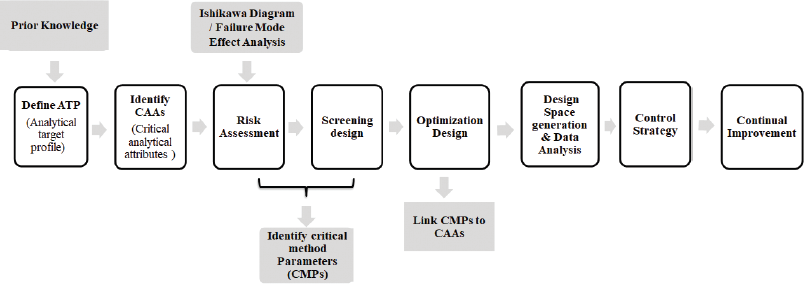 | Figure 1. A complete flow layout of AQbD scheme. [Click here to view] |
Rational and systematic adoption of quality by design (QbD) elements to analytical method development to achieve optimal method performance is termed as analytical QbD (AQbD) (Jayagopal and Shivashankar, 2017; Reid et al., 2013b). This approach guarantees the high quality and reliability of the analytical method and diminishes the risk of failure in the validation phase and routine practice. It is a scientific and risk-based approach for the understanding of the critical analytical attributes (CAAs) and influential independent factors impacting the method performance. Instituted on the doctrines of risks assessment and design of experiments, AQbD offers the in-depth knowledge about the possible risks and connected interactions between the method variables (Borman et al., 2010; Jayagopal and Shivashankar, 2017; Karmarkar et al., 2011; Reid et al., 2013a; 2013b). Besides, AQbD helps in reducing and controlling the source of variability to gain in-process information for taking control decisions promptly. Figure 1 portrays a complete flow layout of AQbD scheme.
Cholecalciferol (CHL), renowned as vitamin D3, is the most widely prescribed drug for vitamin D3 deficiency. Vitamin D3 deficiency is associated with osteoporosis and osteomalacia in adults and rickets in children (Holick and Chen, 2008). CHL plays a critical role in calcium and phosphorus homeostasis and skeletal mineralization (Gueli et al., 2012). In common medical practice, vitamin D3 deficiency is normally treated with CHL ranging from 400 to 1,000 IU/day. Recent studies of the physiologic effects of vitamin D3 suggest its role in autoimmune diseases like cancers, type 1 diabetes mellitus, hypertension, multiple sclerosis, Alzheimer’s disease, and cognitive impairment (Marques et al., 2010). Chemically, it is (3β, 5Z, 7E)-9, 10-secocholesta-5,7,10(19)-trien-3-ol. CHL exists as a white, odorless needle-like crystalline powder, soluble in ethanol, benzene, acetone, chloroform, and fatty oils but practically insoluble in water. The log P of the drug substance is 10.24 at 20oC and pH 7. The molecular weight of CHL is 384.64 g/mol and formula is C27H44O. Figure 2 depicts the chemical structure of the CHL.
The USP analytical method is the only reliable method for CHL estimation, but suffers from various disadvantages of having complicated, tedious, multiple extraction steps that make it as time-consuming method. Also, the majority of published HPLC-UV methods of vitamin D3 have limited application as they have complex mobile phase composition, no stability indicating capability, longer retention time, i.e., more than 10 minutes and mostly followed by time consuming and complicated sample preparation for instance solid phase extraction or supercritical fluid extraction (Al-Qadi et al., 2010; Gamiz-Gracia et al., 2000; Kienen et al., 2008; Klejdus et al., 2004; Kucukkolbasti et al., 2013; Luque-Garcia and de Castro, 2001; Moreno and Salvado, 2000; Sarioglu et al., 2001). Moreover, scientific and risk-based AQbD-oriented approach to reversed-phase HPLC (RP-HPLC) method development of CHL has not been widely discussed till date. Therefore, there is an unmet need for the development of robust, simple, and highly sensitive HPLC method of CHL using AQbD principles to overcome the problems as mentioned above and to ensure the quality of the method throughout the material lifecycle.
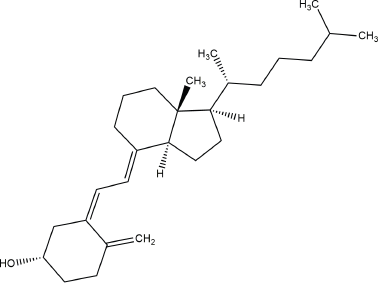 | Figure 2. Chemical structure of Cholecalciferol. [Click here to view] |
In this research article, the ultimate goal of present work was to develop simple, rapid, sensitive, robust, effective, and reliable stability-indicating HPLC method by applying AQbD principles and methodology for assessment of CHL in bulk drug and pharmaceutical drug products, i.e., CHL 400 IU mouth dissolving tablets and marketed 60000 IU chewable (Tayo 60k) tablets.
MATERIALS AND METHODS
Experimental
Chemicals and reagents
CHL (purity 99.7%, 40,000 IU/mg) was obtained as a gift sample from Fermenta Biotech Ltd, Mumbai, India; used as a reference standard. HPLC grade acetonitrile (ACN) and methanol (MeOH) were purchased from Avantor Performance Materials India Ltd, Thane, India. The mobile phase was filtered using 0.45-μm nylon membrane filters made by Pall India Pvt Ltd, Mumbai, India, was sonicated, and degassed using sonicator. In-house 400 IU vitamin D3 mouth dissolving tablets (MDTs) and marketed cholecalciferol 60,000 IU chewable tablets (Tayo 60k manufactured by Eris Lifesciences Pvt. Ltd.) were analyzed for assay by use of the established RP-HPLC method.
Instrumentation and chromatographic conditions
The HPLC method development of CHL was performed on Jasco AS-2055 plus (Tokyo, Japan) containing a system controller, quaternary gradient pump, mobile phase degasser, autoinjector (injection volume ranging between 5 and 100 µl) and photodiode array (PDA) detector. Chromatographic separation was achieved on a reversed-phase C8 column, Eurosphere® 100-5 C8 (M/S KNAUER Wissenschaftliche Gerate GmbH, Berlin, Germany) with a dimension of 250 mm × 4.6 mm and particle size 5 µm, at the room temperature. Isocratic elution was employed with ACN and MeOH (50:50, % v/v) as mobile phase and PDA detection was carried out at 265 nm. Before the chromatographic analysis of test solutions, the column was saturated with the mobile phase for 60 minutes. The 50 µl of sample was injected for the quantification of CHL. The run time of all the test samples was kept 10 minutes. The run time for forced degradation test samples was extended up to 20 minutes to estimate probable co-eluting degradation products. The data acquisition, analysis, and storage were performed by using Jasco ChromNAV software.
Preparation of standard stock solution
The stock solution of CHL was prepared by dissolving accurately weighed 25 mg of the drug in 50 ml of MeOH. The drug solution was sonicated to dissolve the drug, and then 1 ml of this stock solution transferred into 100 ml of amber colored volumetric flask, and it was diluted up to 100 ml with HPLC grade MeOH (final concentration, 200 IU/ml, knowing that 1 IU of vitamin D3 = 0.025 µg). It was used for both screening and optimization experiments. The working standard solutions of CHL were prepared by subsequent dilutions of the stock solution. The series of dilutions were done using HPLC grade MeOH and filtered using a 0.45 syringe filter. Then, these dilutions were transferred to vials before chromatographic analysis.
Defining the method goals, i.e., analytical target profile (ATP)
The AQbD-based methodology defines and proposes vital elements of ATP for the stepwise, scientific development of the analytical method. The method goals cover a possible summary of the quality features of the analytical method. Table 1 depicts vital elements of ATP framework for obtaining an efficient HPLC method for CHL.
Critical analytical attributes (CAAs)
To achieve the anticipated ATP, various CAAs were recognized and explored. These are peak area, retention time, theoretical plates, and peak tailing factor.
 | Table 1. Vital elements of ATP for HPLC method of CHL. [Click here to view] |
Risk assessment studies
Risk assessment studies were performed to identify the critical method parameters (CMPs), which are high-risk factors and have a critical impact on the CAAs. In the risk assessment plan, Ishikawa fishbone diagram was constructed to identify potential risk factors that may have an effect on method performance and corresponding causes. This could be method factors like extraction method, extraction time, extraction solvent, etc. and instrumental settings such as chromatographic mode, mobile phase ratio, flow rate, injection volume, etc. From this, high-risk method variables were shortlisted based on criticality and impact on the method CAAs and exposed to further analysis by applying suitable screening and experimental optimization design.
Taguchi orthogonal array screening study design
Taguchi orthogonal array (TOA) design is a multifactorial two-level design that can be applied for identification and control of the main effect independent variables with a minimum number of experiment runs from various suspected independent factors (Dash et al., 2016; Sahu et al., 2017). Therefore, this experimental design was generally employed for identification of independent factors that could be fixed or eliminated in further study.
The TOA design was employed in this study for screening studies to recognize the CMPs censoriously influencing the method CAAs using the following polynomial model as shown in the following equation:.
Y = A0 + A1X1 + A2X2 + A3X3 + A4X4 + A5X5 + A6X6 + A7X7 (1)
where, Y is the response variable, A0 is the constant, and A1, A2, A3, A4, A5, A6, and A7 are the regression coefficients of the independent factors.
Table 2 represents the TOA design layout enlisting the different factors with respective low (−1) and high levels (+1) and their studied responses (theoretical plates and peak tailing factor). Standard Pareto charts were drawn to illustrate the effect of each independent factor on the specified responses. Then, the critical factors were recognized and further employed for Box–Behnken design.
Box–Behnken optimization study design
The optimization of chromatographic conditions was performed by employing three factors, three levels Box–Behnken design to estimate the main, interaction and quadratic effects of critical factors on the specified response variables (Ahmad et al., 2016; Beg et al., 2012; Ferreira et al., 2007; Sahu et al., 2015; 2017; Wani and Patil, 2017). In the present study, the Box–Behnken experimental design, comprising 15 experiment runs with 12 factorial points and three center points, was employed to get design space for attaining the desired ATP. The polynomial quadratic equation is generated by this design as shown in the following equation:
Y = B0 + B1X1 + B2X2 + B3X3 + B12X1X2 + B23X2X3 + B13X1X3 + B11X12 + B22X22 + B33X32 (2)
where Y is the response variable, B0 is the constant, and B1, B2, and B3 are the regression coefficients of the linear terms of X1, X2, and X3, respectively. B12, B23, and B13 are the regression coefficients for the interaction terms of X1X2, X2X3, and X1X3, respectively. B11, B22, and B33 are the regression coefficients for the squared terms of X12, X22, and X32, respectively.
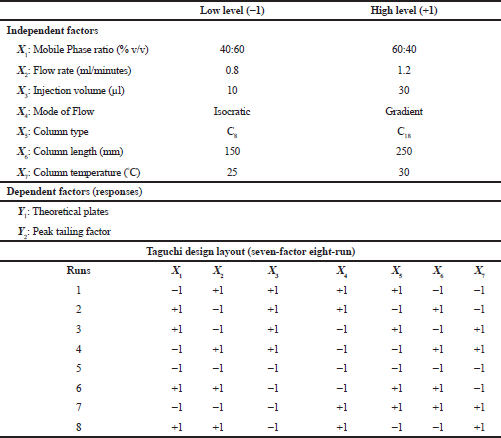 | Table 2. Chromatographic factors and response variables for Taguchi experimental design. [Click here to view] |
The independent variables selected were mobile phase [ACN:MeOH] ratio (X1), flow rate (X2), and injection volume (X3), whereas peak area (Y1), retention time (Y2), theoretical plates (Y3), and peak tailing factor (Y4) were selected as the dependent responses. The Box–Behnken optimization study design layout is shown in Table 3.
Analytical method validation
The optimized chromatographic method was validated as per the ICH Q2 (R1) guidelines for specificity, linearity, accuracy, precision, limit of detection (LOD), limit of quantitation (LOQ), robustness, and ruggedness (Guideline ICH, 2005).
Forced degradation studies
Forced degradation of CHL was executed to deliver a sign of the stability indicating properties and specificity of the established method (Blessy et al., 2014; Krishna et al., 2016). PDA detection was employed to analyze the purity of degraded test samples. The stress conditions used for the degradation study included acid hydrolysis (1 N HCl), base hydrolysis (1 N NaOH), All the test samples were filtered using a 0.45 μm nylon membrane filter and analyzed to estimate the percent degradation of CHL.
Application of the analytical method for analysis of CHL in tablet dosage form
The established and validated analytical method for CHL was applied for its determination in in-house CHL 400 IU mouth dissolving tablets (50% overages) and marketed 60,000 IU (Tayo 60k) chewable tablets. Vitamin D3 MDTs (50% overages) were manufactured by blending stabilized CHL (100 IU/mg) with other excipients by direct compression technique. To determine the content of CHL in the developed MDTs and marketed chewable tablets, 20 tablets were weighed and finely powdered with the help of mortar and pestle. The required quantity of powder was accurately weighed and transferred to a volumetric flask containing HPLC grade MeOH and sonicated for 30 minutes, for complete extraction of the drug to take place.Finally, this prepared test sample was filtered through 0.45 μm nylon membrane before using it for analysis. The analysis was performed in five replicates.
RESULT AND DISCUSSION
Preliminary method development studies
The preliminary studies were performed according to previously reported literature for the development of HPLC method for the estimation of CHL in pharmaceutical dosage forms. The RP-HPLC method was successfully employed for evaluation of CHL. First, several combinations of mobile phase were tried by using ACN and MeOH at a variable flow rate between 0.8 and 1.2 ml/minutes. From preliminary studies, it was found that the selection of ACN and MeOH as a mobile phase composition showed excellent chromatographic resolution with low peak tailing factor.
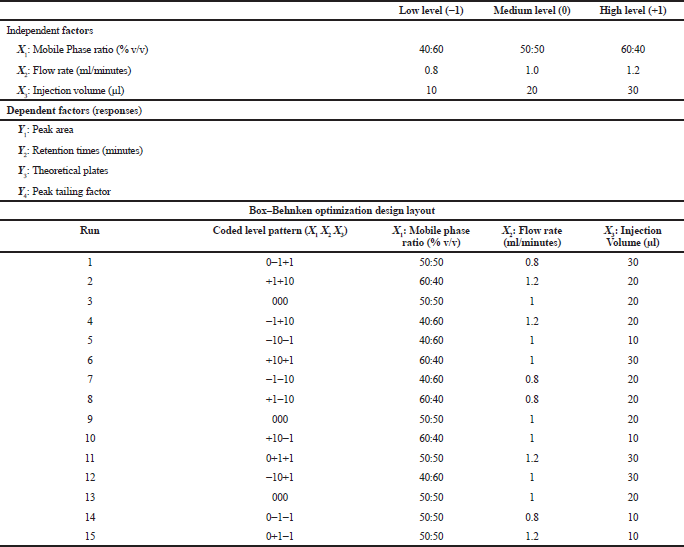 | Table 3. Chromatographic factors and response variables for Box–Behnken optimization design. [Click here to view] |
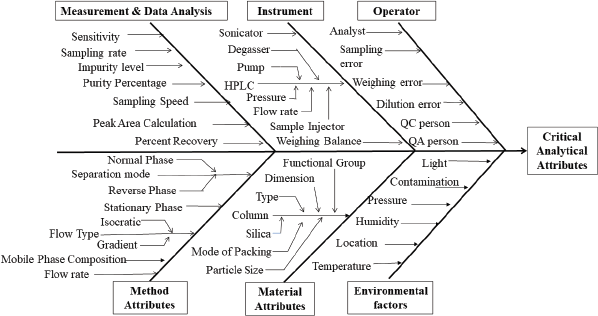 | Figure 3. Ishikawa Fish-bone diagram illustrating the influence of possible factors on CAAs of analytical method of CHL. [Click here to view] |
Risk assessment studies
Risk assessment studies as per ICH Q9 guidelines were performed with an objective to get all the possible high impact factors which will be subjected to the design of experiment study to establish method operable design region. Ishikawa fish-bone was used for risk identification and risk assessment. Figure 3 depicts the effect of possible key factors such as method & material attributes, environmental factors, operator, instrument requirements, and measurement & data analysis affecting on method performance. It illustrates the cause and effect relationship between method parameters and CAAs of the analytical method of CHL. Risk assessment studies identified seven high potential risk factors such as X1: mobile phase ratio (% v/v), X2: flow rate (ml/minutes), X3: injection volume (µl), X4: mode of flow, X5: column type, X6: column dimension (mm), and X7: column temperature (°C). These factors have potential impact on critical analytical attributes (CAAs), i.e., theoretical plates (Y1) and peak tailing factor (Y2). These seven factors would be used for further screening study to get the major factors affecting selected CAAs by Taguchi orthogonal array (TOA) design.
Taguchi orthogonal array screening study design
Ideally, screening designs are applied when numerous independent factors expected to have an impact on a specific response. The objective of this study was to identify the most significant factors influencing the CAAs by using TOA screening study design. TOA design was used to estimate the main effects of seven independent factors on selected CAAs. Figure 4 shows the standard Pareto charts illustrating the impact of method parameters on the CAAs of the method. The standard Pareto ranking analysis presented that the factors, such as mobile phase ratio, flow rate, and injection volume, had a significant impact on method CAAs. Hence, these factors were selected as CMPs for further analytical optimization study employing Box–Behnken design.
The standard Pareto charts were derivative of multivariate regression analysis and the length of each bar in the Pareto chart is equal to the magnitude of the regression coefficient of that factor. It was observed that little change in mobile phase ratio, flow rate, and injection volume resulted in a pronounced change in CAAs. Henceforth, these factors needed to be strictly controlled while the effect of mode of flow, column type, column length, and column temperature were found to be statistically insignificant. Based on the desirability function of Taguchi screening design, mobile phase ratio, flow rate, and injection volume were optimized further by Box–Behnken optimization design to detect main, interaction and quadratic effects of these factors on peak area, retention time, theoretical plates, and peak tailing factor.
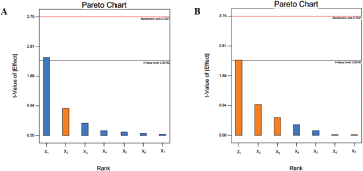 | Figure 4. Standard Pareto charts showing effects of independent variables on analytical method CAAs. (A) Theoretical plates and (B) peak tailing factor of CHL during the screening. [Click here to view] |
Box–Behnken optimization study design
This study aimed at detecting the main, interactions and quadratic effects of mobile phase ratio, flow rate, and injection volume on peak area (Y1), retention time (Y2), theoretical plates (Y3), and peak tailing factor (Y4). The 15 experimental runs were performed, and obtained results were statistically analyzed using Design expert software version 7.0.0 (Stat-Ease Inc., Minneapolis, MN). The software performs response surface methodology, which includes the multiple regression analysis (MRA), analysis of variance (ANOVA), and statistical optimization. The classical polynomial quadratic equation in terms of coded factors for each selected CAAs estimating regression coefficients are shown in the following equations:
Peak area (Y1) = 11744.33 − 319.75X1 − 14.88X2 + 226.88X3 − 44.00X1X2 + 95.50X2X3 + 204.25X1X3− 3260.04X12 − 3059.79X22 − 3375.29X32 (3)
Retention time (Y2) = 5.03 + 0.088X1 − 0.11X2 + 0.025X3 + 0.100X1X2 − 0.025X2X3 + 0.025X1X3 − 0.092X12 − 0.49X22 − 0.32X32 (4)
Theoretical plates (Y3) = 11442.00 + 500.12X1 − 34.13X + 88.50X3 − 50.25X1X2 + 124.00X2X3 −70.50X1X3 − 2164.13X12 − 1249.62X22 − 1279.38X32 (5)
Peak tailing factor (Y4) = 1.00 − 0.094X1 − 0.059X2 − 0.023X3 + 0.045X1X2 + 0.052X2X3 + 0.052X1X3 + 0.22X12 + 0.17X22 + 0.19X32 (6)
The ANOVA results for each CAAs were shown in Table 4. The ANOVA with its significance method for all CAAs proves that the relationship between response and variables is statistically significant (p < 0.05). The value of correlation coefficient (R2) for all CAAs indicates a perfect fit of the model. This implies that the model is valid. The adjusted R-squared was a more valuable marker of the variation in response variables, while predicted R-squared indicated how well the model could predict future data, relatively high values of adjusted and predicted R-squared inferred that the applied statistical model effectively predicted the response. The main effects (B1, B2, and B3) signify the average response of varying one factor at a time from its low to high level. The interaction term (B12, B23, and B13) shows how the response changes when two factors are concurrently altered. The polynomial quadratic terms (B11, B22, and B33) were added to examine nonlinearity. The Polynomial quadratic equations were employed to conclude after considering the magnitude of coefficients and the mathematical sign it carries, i.e., positive or negative.
From Equation (3), it was observed that factors X1 and X2 have a negative effect, while X3 has a positive effect on the peak area. Negative value coefficients of X1 and X2 factor indicate that peak area increases with a decrease in the mobile phase ratio and flow rate, whereas positive sign of coefficients of X3 terms indicates that low to medium level of injection volume favors the increased peak area. When the coefficient values of independent key variables (X1, X2, and X3) compared, the coefficient value of variable X3 (226.88) was found to be higher, and hence injection volume was considered to be a major contributing factor for incredible effect on peak area (Y1).
From Equation (4), variation in mobile phase ratio significantly affects the retention time as the coefficient value of X1 was found to be maximum among all independent factors. The polynomial equation for retention time suggests that factor X1 has a positive effect on Y2, up to a particular concentration. After a particular concentration factor, X1 has a negative effect on Y2 as indicated by the negative sign of the coefficient of X1.
Equation (5) showed that the positive value of coefficients of X1 and X3 factor indicates that theoretical plates increase with the increase in the mobile phase ratio and injection volume up to medium level. After a medium level factor, X1 and X3 have a negative effect on Y3 as indicated by the negative sign of the coefficient of X1 and X3. Mobile phase ratio was considered to be an influential factor to have a major impact on theoretical plates as the coefficient value of variable X1 was found to be higher.
From Equation (6), it was observed that the negative sign of coefficients of X1, X2, and X3 terms indicates that low to medium level of independent factors favors the lesser tailing factor. From medium to high level of factors displays increased peak tailing factor. As compared to the magnitude of all factor coefficients, injection volume showed the influential impact on peak tailing factor, while the flow rate was found to have relatively less impact on the peak tailing factor. Minimum values were observed at the intermediate level.
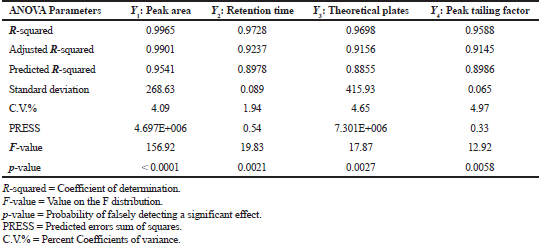 | Table 4. ANOVA results for each CAAs. [Click here to view] |
Three-dimensional surface and 2-D contour plots were also analyzed to define design space and to visualize the effect of independent factors and their interactions on the concerned response variables. Since the proposed model has more than two independent factors, one factor was kept constant for each plot. These plots were found to agree with MRA and ANOVA parameters. Figure 5 portrays 3D surface plot, and it’s corresponding 2D contour plot depicting the effects of mobile phase ratio, flow rate and injection volume on peak area, retention time, theoretical plates, and peak tailing factor.
Identification for optimum method conditions
Identification for optimum method conditions was performed by numerical optimization simply by trading off different CAAs to gain anticipated targets, i.e., maximum theoretical plates, peak area, retention time around 5 minutes, and minimum peak tailing factor (about 1.0). Desirability function close to one was selected as the optimum solution. The optimized method conditions were found to be mobile phase ratio of 50:50 (%v/v) ACN and MeOH, the injection volume of 20 µl, and flow rate of 1 ml/minutes with the desirability of 0.958 (as shown in Fig. 6). The graphical optimization was found to agree numerical optimization and estimated optimized solution was found within operable analytical design space. The yellow region in an overlay plot indicated optimum method conditions suggested by design expert software to obtain method targets as shown in Figure 6.
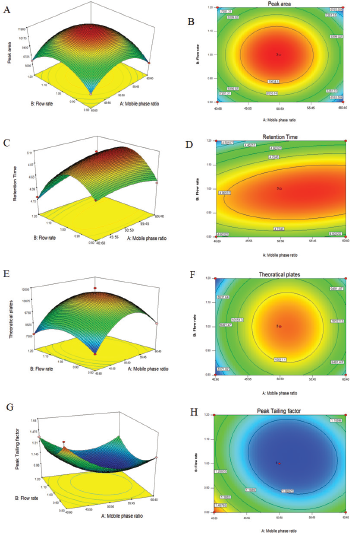 | Figure 5. 3D surface and 2D Contour plots depicting the effect of (A and B) mobile phase ratio and flow rate on peak area, (C and D) retention time, (E and F) theoretical plates, and (G and H) peak tailing factor. [Click here to view] |
Analytical method validation
Figure 7 showed the chromatogram of placebo mixture, standard drug solution, and developed 400 IU MDTs. The placebo does not show any drug peak in the chromatogram. Figure 7B shows the standard chromatogram of 40 IU/ml of CHL with Rt 5.0 minutes. Figure 7C shows the chromatogram of the drug in a formulation, which confirms no change in the chromatogram of a drug in the presence of other ingredients. There was no interference observed at the retention time of drug peak; thus, method was found to be specific for CHL. Standard calibration curve of CHL in MeOH was plotted in the range of 20–100 IU/ml (Fig. 8). The method was found to be linear in the selected concentration range with a regression coefficient of 0.9993.
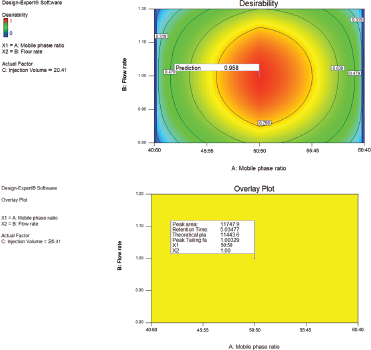 | Figure 6. Desirability and overlay contour plot showing optimum method operable design region. [Click here to view] |
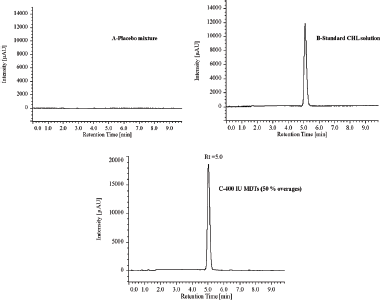 | Figure 7. Chromatograms depicting (A) placebo mixture, (B) standard CHL solution, and (C) CHL in the developed formulation, i.e., 400 IU (50% overages) MDTs. [Click here to view] |
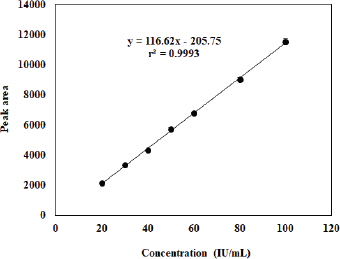 | Figure 8. Calibration curve of vitamin D3 in MeOH. [Click here to view] |
Data represented in Table 5 summarise the system, intraday and interday precision, solution stability, robustness, and ruggedness of established HPLC method. It can be observed from the table that relative standard deviation % relative standard deviation (RSD) of each parameter for validation falls within the limit, i.e., not more than 2%.
The LOD and LOQ concentrations were found to be 10 and 20 IU/ml, respectively. The stability of the drug solution of concentration 100 IU/ml up to 24 hours was estimated by using the established HPLC method. Vitamin D3 was found to be stable in the MeOH. No peaks corresponding to degradation products were observed. The robustness of the projected method was estimated by altering mobile phase composition from Acetonitrile: Methanol 48:52–52:48 v/v, varying the injection volume from 19.5 to 20.5 ml and changing the flow rate from 0.9 to 1.1 ml/minutes. Acceptable %RSD values were obtained after making small deliberate changes in the ratio of mobile phase, injection volume, and flow rate. This indicates that the method is robust for the envisioned purpose. The ruggedness of the analytical method by different analysts and different instrument confirms the reliability of the analytical method for ruggedness in the chromatographic conditions.
An excellent recovery with %RSD of less than 2% was obtained from all three levels, i.e., 70%, 100%, and 130%. The %RSD of all the three levels is shown in Table 6. The developed method did not include any pre-treatment, complicated-tedious stages for extraction of CHL. Hence, there was not any recovery problem with this method.
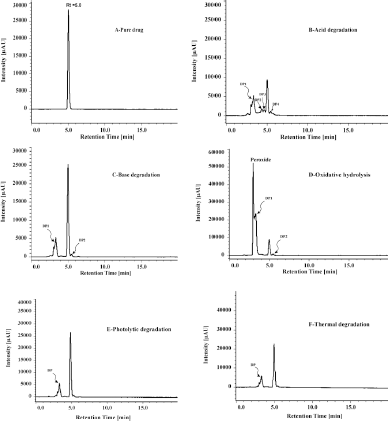 | Figure 9. Chromatograms depicting CHL and its DPs under stress conditions (A) Pure drug (B) Acidic (C) Basic (D) Oxidative hydrolysis/Peroxide (E) Photolytic (F) Thermal degradation [Click here to view] |
Forced degradation studies
The Forced degradation studies were carried out by analyzing the test samples under all stress conditions and computed the percent degradation of CHL for each stress condition as shown in Table 7. In short, the forced degradation studies revealed that the established method was sensitive enough for the determination of DPs.
Application of the analytical method for analysis of CHL in tablet dosage form
The chromatographic analysis of 400 IU MDTs and marketed Tayo 60k chewable tablets showed excellent recovery on the assay. The percent recovery of in-house developed 400 IU MDTs and marketed Tayo 60 K chewable tablets were found to be 99.89% and 101.46%, respectively. Moreover, the retention time of CHL in tablet formulation showed unchanged with respect to standard CHL solution. Nevertheless, the theoretical factors and peak tailing factor were found to be within the acceptable limits. All test samples showed no unwanted extra peaks in chromatograms that suggested there was no inference of other tablet excipients with CHL. This confirmed a high degree of ability of established method for routine analysis of CHL in bulk and pharmaceutical dosage forms.
Future Research Plan
The degradation pathway of Cholecalciferol can be further elucidated by using of liquid chromatography-tandem mass spectrometry technique.
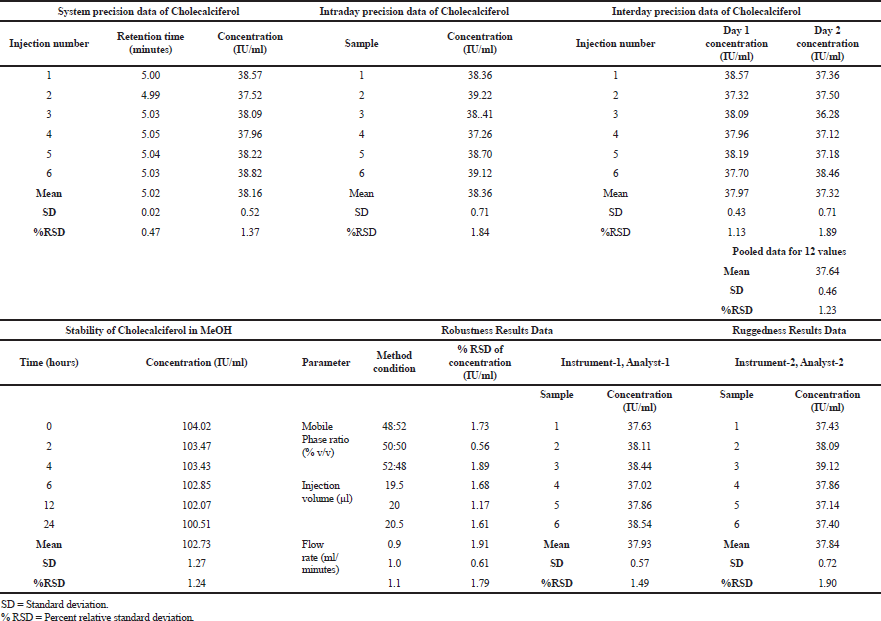 | Table 5. Analytical method validation of cholecalciferol. [Click here to view] |
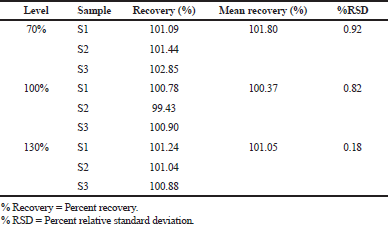 | Table 6. Recovery studies of Cholecalciferol formulations. [Click here to view] |
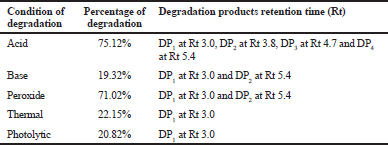 | Table 7. Forced degradation studies of Cholecalciferol. [Click here to view] |
CONCLUSION
The present article successfully demonstrates the effectiveness of quality by design concept to optimize the HPLC chromatographic method for CHL analysis with a better understanding of the critical factor-response relationship for augmenting the method performance. This AQbD-driven HPLC method development of CHL ensured robustness of the analytical method before validation studies. This novel approach helps the analyst to define control strategies to decrease the undesirable effect of these CMVs on method performance. The validation studies confirmed excellent linearity, accuracy, precision with a high degree of specificity, sensitivity, robustness, and ruggedness. The forced degradation studies on established HPLC method of CHL easily identified degradation products while exposing to a variety of stress conditions. It was found that CHL was rapidly degraded under oxidative, hydrolytic (acid and alkali), and photolytic conditions. The developed, validated method further used for the analysis of in-house developed vitamin D3 (400 IU) MDTs and marketed chewable tablets Tayo 60k (60,000 IU) to ratify the applicability of the method. Overall, practicing the AQbD approach for estimation of CHL in tablet dosage form ensured stepwise, scientific, risk-based method development where quality assurance will be guaranteed.
ACKNOWLEDGMENT
The author would like to thank the University Grants Commission (UGC), New Delhi, India, for providing financial grants to carry out present work as a Research fellow under UGC-BSR scheme [No. F.5-63/2007 (BSR) Dated on 16/02/2015]. Authors would also like to thank Merck Specialities Pvt Ltd, Mumbai, India, for providing chemicals and necessary facilities. The authors gratefully acknowledge to Fermenta Biotech Ltd, Mumbai, India, for providing the gift sample of CHL. The author appreciates the vital inputs from Mr. Pradipkumar Wavhule during the compilation of this manuscript.
ABBREVIATIONS
ACN Acetonitrile
ANOVA Analysis of variance
AQbD Analytical quality by design
ATP Analytical target profile
BBD Box–Behnken design
CAAs Critical analytical attributes
CHL Cholecalciferol
CMPs Critical method parameters
DPs Degradation products
ICH International Council for Harmonization
LC-MS Liquid chromatography-tandem mass spectrometry
LOD Limit of detection
LOQ Limit of quantitation
MDTs Mouth dissolving tablets
MeOH Methanol
MRA Multiple regression analysis
PDA Photodiode array
RP-HPLC Reversed-phase high-performance liquid chromatography
RSM Response surface methodology
TOA Taguchi orthogonal array
USFDA United States Food and Drug Administration
CONFLICTS OF INTEREST
The authors declare that there are no conflicts of interest.
FINANCIAL SUPPORT
University grants commission (UGC), New Delhi, India, has provided financial grants to carry out present research work. Merck Specialities Pvt Ltd, Mumbai, India, has provided the chemicals and necessary facilities for production of in-house 400 IU MDTs.
REFERENCES
Ahmad A, Raish M, Alkharfy KM, Mohsin K, Shakeel F. Box-Behnken supported development and validation of robust RP-HPLC method: an application in estimation of pravastatin in bulk and pharmaceutical dosage form. J Chil Chem Soc, 2016; 61:2963–7. CrossRef
Al-Qadi E, Battah A, Hadidi K. Development of high-performance liquid chromatographic method for vitamin D3 analysis in pharmaceutical preparation. Jordan J Pharm Sci, 2010; 3:78–86.
Awotwe-Otoo D, Agarabi C, Faustino PJ, Habib MJ, Lee S, Khan MA, Shah RB. Application of quality by design elements for the development and optimization of an analytical method for protamine sulfate. J Pharm Biomed Anal, 2012; 62:61–7. CrossRef
Beg S, Kohli K, Swain S, Hasnain MS. Development and validation of RP-HPLC method for quantitation of amoxicillin trihydrate in bulk and pharmaceutical formulations using Box-Behnken experimental design. J Liq Chromatogr Relat Technol, 2012; 35:393–406. CrossRef
Blessy M, Patel RD, Prajapati PN, Agrawal YK. Development of forced degradation and stability indicating studies of drugs—a review. J Pharm Anal, 2014; 4:159–65. CrossRef
Borman P, Roberts J, Jones C, Bale S. The development phase of an LC method using QbD principles. Sep Sci, 2010; 2:2–8.
Bossunia MTI, Urmi KF, Chironjit Kumar S. Quality-by-design approach to stability indicating RP-HPLC analytical method development for estimation of Canagliflozin API and its validation. Pharm Methods, 2017; 8(2):92–101. CrossRef
Dash RN, Mohammed H, Humaira T. An integrated Taguchi and response surface methodological approach for the optimization of an HPLC method to determine glimepiride in a supersaturatable self-nanoemulsifying formulation. Saudi Pharm J, 2016; 24:92–103. CrossRef
Ferreira SLC, Bruns RE, Ferreira HS, Matos GD, David JM, Brandao GC, da Silva EGP, Portugal LA, dos Reis PS, Souza AS, dos Santos WNL. Box-Behnken design: an alternative for the optimization of analytical methods. Anal Chim Acta, 2007; 597:179–86. CrossRef
Gamiz-Gracia L, Jiménez-Carmona MM, de Castro MDL. Determination of vitamins D 2 and D 3 in pharmaceuticals by supercritical-fluid extraction and HPLC separation with UV detection. Chromatographia, 2000; 51:428–32. CrossRef
Ganorkar SB, Dhumal DM, Shirkhedkar AA. Development and validation of simple RP-HPLC-PDA analytical protocol for zileuton assisted with design of experiments for robustness determination. Arab J Chem, 2017; 10:273–82. CrossRef
Garg NK, Sharma G, Singh B, Nirbhavane P, Katare OP. Quality by design (QbD)-based development and optimization of a simple, robust RP-HPLC method for the estimation of methotrexate. J Liq Chromatogr Relat Technol, 2015; 38:1629–37. CrossRef
Gueli N, Verrusio W, Linguanti A, Maio FD, Martinez A, Marigliano B, Cacciafesta M. Vitamin D: drug of the future. A new therapeutic approach. Arch Gerontol Geriatr, 2012; 54:222–7. CrossRef
Guideline ICH. Validation of analytical procedures: text and methodology Q2 (R1). International Conference on Harmonization, Geneva, Switzerland, pp 11–12, 2005.
Holick MF, Chen TC. Vitamin D deficiency: a worldwide problem with health consequences. Am J Clin Nutr, 2008; 87:1080S–6S. CrossRef
ICH Assembly, Kobe, Japan, June. 2018. Available via http://www.ich.org/ichnews/press-releases/view/article/ich-assembly-kobe-japan-june-2018.html
Jayagopal B, Shivashankar M. Analytical quality by design—a legitimate paradigm for pharmaceutical analytical method development and validation. Mech Mater Sci Eng J, 2017; 9:1–11.
Karmarkar S, Garber R, Genchanok Y, George S, Yang X, Hammond R. Quality by design (QbD) based development of a stability indicating HPLC method for drug and impurities. J Chromatogr Sci, 2011; 49:439–46. CrossRef
Kienen V, Costa WF, Visentainer JV, Souza NE, Oliveira CC. Development of a green chromatographic method for determination of fat-soluble vitamins in food and pharmaceutical supplement. Talanta, 2008; 75(1):141–6. CrossRef
Klejdus B, Petrlova J, Potesil D, Adam V, Mikelova R, Vacek J, Kizek R, Kuban V. Simultaneous determination of water-and fat-soluble vitamins in pharmaceutical preparations by high-performance liquid chromatography coupled with diode array detection. Anal Chim Acta, 2004; 520:57–67. CrossRef
Krishna MV, Dash RN, Reddy BJ, Venugopal P, Sandeep P, Madhavi G. Quality by design (QbD) approach to develop HPLC method for eberconazole nitrate: application oxidative and photolytic degradation kinetics. J Saudi Chem Soc, 2016; 20:S313—22. CrossRef
Kucukkolbasti S, Ires N, Kara H. Development of method to simultaneous determination of some water and fat soluble vitamins in feeding additives. J Selcuk Univ Nat Appl Sci, 2013; 1:30–47.
Luque-Garcia JL, de Castro MDL. Extraction of fat-soluble vitamins. J Chromatogr A, 2001; 935:3–11. CrossRef
Marques CD, Dantas AT, Fragoso TS, Duarte AL. The importance of vitamin D levels in autoimmune diseases. Rev Bras Reumatol, 2010; 50:67–80. CrossRef
Monks KE, Rieger HJ, Molnar I. Expanding the term “Design Space” in high performance liquid chromatography (I). J Pharm Biomed Anal, 2011; 56:874–9. CrossRef
Moreno P, Salvado V. Determination of eight water-and fat-soluble vitamins in multi-vitamin pharmaceutical formulations by high-performance liquid chromatography. J Chromatogr A, 2000; 870:207–15. CrossRef
Panda SS, Ravi Kumar Bera VV, Beg S, Mandal O. Analytical Quality by Design (AQbD)-oriented RP-UFLC method for quantification of lansoprazole with superior method robustness. J Liq Chromatogr Relat Technol, 2017; 40:479–85. CrossRef
Peraman R, Bhadraya K, Padmanabha Reddy Y. Analytical quality by design: a tool for regulatory flexibility and robust analytics. Int J Anal Chem, 2015; 2015:1–9. CrossRef
Reid GL, Cheng G, Fortin DT, Harwood JW, Morgado JE, Wang J, Xue G. Reversed-phase liquid chromatographic method development in an analytical quality by design framework. J Liq Chromatogr Relat Technol, 2013a; 36:2612–38.
Reid GL, Morgado J, Barnett K, Fortin D. Analytical quality by design (AQbD) in pharmaceutical development. Am Pharm Rev, 2013b; 16(5).
Rozet E, Lebrun P, Hubert P, Debrus B, Boulanger B. Design spaces for analytical methods. TrAC Trends Anal Chem, 2013; 42:157–67. CrossRef
Sahu PK, Ramisetti NR, Cecchi T, Swain S, Patro CS, Panda J. An overview of experimental designs in HPLC method development and validation. J Pharm Biomed Anal, 2018; 147:590–611. CrossRef
Sahu PK, Swain S, Prasad GVS, Panda J, Murthy YLN. RP-HPLC Method for determination of metaxalone using Box-Behnken experimental design. J Appl Biopharm Pharmacokinet, 2015; 2:40–9. CrossRef
Sarioglu K, Celebi SS, Mutlu M. A rapid method for determination of vitamins D2 and D3 in pharmaceutical preparations by HPLC. J Liq Chromatogr Relat Technol, 2001; 24:973–82. CrossRef
Thakur D, Kaur A, Sharma S. Application of QbD based approach in method development of RP-HPLC for simultaneous estimation of antidiabetic drugs in pharmaceutical dosage form. J Pharm Investig, 2017; 47:229–39. CrossRef
Wani YB, Patil DD. An experimental design approach for optimization of spectrophotometric method for estimation of cefixime trihydrate using ninhydrin as derivatizing reagent in bulk and pharmaceutical formulation. J Saudi Chem Soc, 2017; 21:S101—11. CrossRef